This report covers:
- Leaked down
- Leaking air hose
- Gotcha!
- The cobbler’s children have no shoes
- Time to get around to it
- How to find the leak
- Disassemble the leaky connection
- Applying Teflon (plumber’s) thread-sealing tape.
- Teflon (plumber’s) tape
- Did it work?
- And the rifle?
- Summary
If there is a fear when buying a precharged pneumatic airgun for the first time, it’s that it will leak. Today we look into that concern in a different way.
I was at the firearms range last Friday, testing the Makarov pistol and another pistol that I will tell you about soon. I also took along the Umarex Gauntlet .30 caliber, because, as I discovered in Part 1 of that series, this rifle is really a big bore that’s too loud and too powerful to shoot in my house.
Leaked down
I had aired up the rifle about four days earlier, knowing that I would be going to the range on Friday. But when I packed it to go the day before I noted that it had leaked down. So it went from full to empty in about three days. No problem, however, because I had just filled both my carbon fiber air tanks with the Air Venturi compressor.
Leaking air hose
I took the 88-cubic foot tank to the range. I knew its microbore air hose (small diameter to waste less air when uncoupling) had a leak at the coupling that attached to the rifle, but once the pressure got past 1000 psi, the leak stopped.
Gotcha!
At least that hose leak had always stopped before. At the range when I tried to air up the Gauntlet reservoir the air never stopped leaking and would not put over 1000 psi into the rifle.
The cobbler’s children have no shoes
There I was — at the rifle range and all set to get material for three blogs when one of them just evaporated before my eyes. And it was my own fault. I had been runnin’ and gunnin’ (literally) for months with that leaky hose, knowing I had to fix it, but I could not ever find my round tuit. [Note for our readers outside the US and Canada — this is an expression we lazy Americans use, “I’ll fix it when I get around to it.”]
Time to get around to it
Well, circumstances had pushed me into a corner. It was time to get around to it, and I thought some of you who fear the dark side of airgunning, as precharged pneumatics are often called, would like to watch. Besides, if I’m going to take the time to do something like this, I really need to get a blog out of it.
How to find the leak
The best way to find a slow leak is to put soapy water on the suspect connection and watch for bubbles. That will show you precisely where the leak is located. But my leak wasn’t slow. It was so fast that I could hear it and feel it by wrapping my hand around the connection. Let me show you.
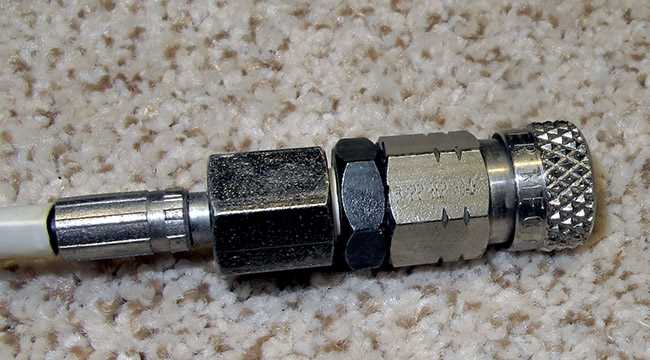
There was no question this was the leaking connection. Putting my hand around it, I could feel the air leaking out.
Disassemble the leaky connection
The first step was to disassemble the leaking connection. When I did I saw that both threaded sides of the interconnecting black piece had no Teflon tape on them. Neither was there any tapered connection that’s sometimes found. No wonder it leaked!
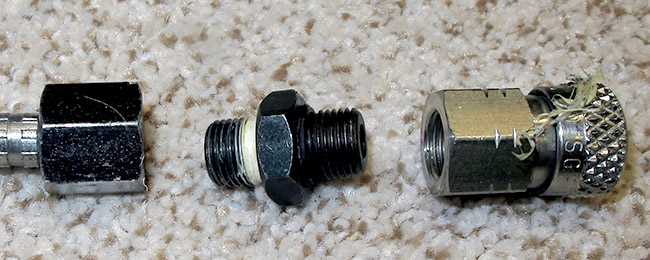
As you can see, the black piece that connects the female Foster connector on the right to the hose connector on the left has no plumber’s (Teflon) thread-sealing tape on it’s threads on either side. The small white band that you see on the left side of this connector is old plumber’s tape that has been wadded up and pushed forward into a smaller non-threaded portion of the connector.
Applying Teflon (plumber’s) thread-sealing tape.
To seal the threads you wrap at least three windings of plumber’s tape around the threads. The direction in which you wrap it is vital to your success. Because you are putting one part into another and twisting them together until the threads bottom out, you have to wrap the tape the right way or it will peel itself off as the parts are threaded together. If the threads are wound clockwise (right-hand twist — the most common way) the tape should be wound on counter-clockwise. That way the threads of the connecting device will try to tighten the tape as the parts are threaded together. Clockwise and counter-clockwise are when looking at the connector from the end you will be connecting to.
I didn’t bother removing the old tape because it wasn’t doing anything anyway. I just wound on three turns of fresh tape.
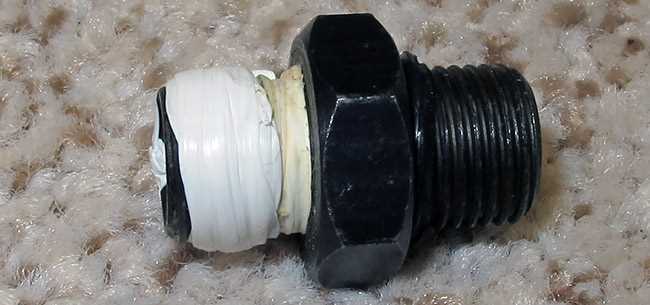
The left side (hose connector side) of the adaptor has been taped. Until I saw this photo enlarged I didn’t realize there was an o-ring on the right side. It didn’t work, so who cares?
Once the black adaptor is screwed tight to the hose connector, I wrapped the right side, that attaches to the female Foster fitting. I didn’t see the o-ring so I didn’t do anything about it, except to tape over it.
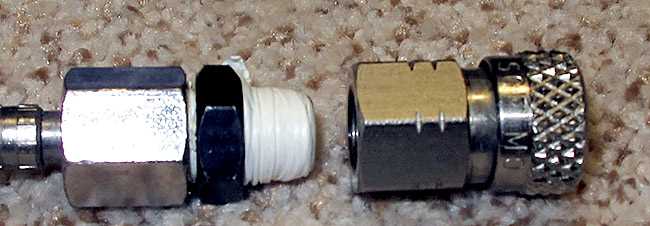
I taped the threads on the right side next and went right over the o-ring that I didn’t see.
Teflon (plumber’s) tape
The Teflon tape you get at the hardware store. It has no sticky side. You apply it under slight tension, so that it stretches just a little. It clings to itself after being applied and once the parts are screwed together it won’t come apart. As long as you wind it on correctly, it should last for many years.
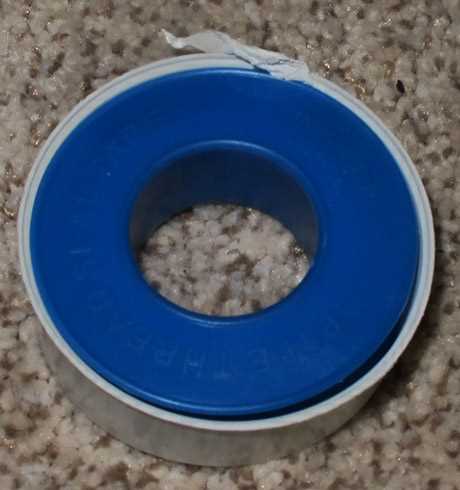
Teflon tape is also called plumber’s tape.
Did it work?
The test for whether it worked is to connect to something and try to inflate it. Since the .30 Gauntlet was also a leaker I decided to use it for this test. That gave me the opportunity to try to fix its leak. Or at the least I could determine how long it took to leak down.
The hose is completely sealed after the fix. I left it at max pressure (4,500 psi/310 bar) for several seconds and saw no decline in pressure on the tank gauge.
And the rifle?
One thing I did to help the Gauntlet stop leaking was introduce a drop of silicone chamber oil as I filled the rifle. Here is what that looks like. Use high flashpoint silicone oil only for this, as petroleum-based oil can ignite and explode under high pressure!
![]()
I put a drop of silicone oil on the filler nipple to be blown into the reservoir at filling. Use high flashpoint silicone oil only for this!
I filled the rifle and took note where the onboard gauge needle stopped, which was two hashmarks into the green portion of the gauge. I will watch this over time and see if the rifle is still leaking. If it is, is the leak slow enough that I can still test the rifle?
Summary
Today you got to look behind the curtain when things didn’t go right. Since this was while testing a PCP — the so-called dark side of airgunning — I thought you’d like a look at what goes on.

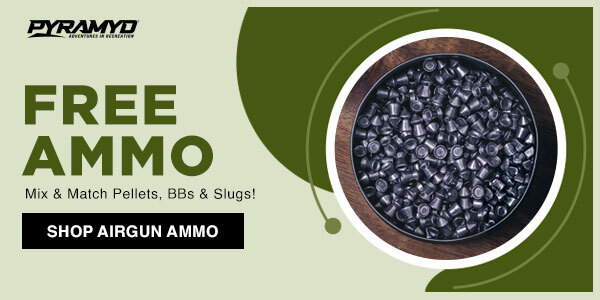
BB,
How does one go about systematically looking for a not so obvious leak? Where does one start?
Siraniko
Siraniko,
As BB stated, a little soapy water is great for slow leaks. I typically add a little silicone oil to the reservoirs of my PCPs as BB has suggested. The silicone oil will “condition” the o rings and help seal any small leak. If that does not work, you may have to have the PCP airgun resealed.
Siraniko,
And if the leak is inside the gun, do what I did. The Gauntlet has not leaked one bit in 21 hours.
Sometimes it helps to insert the oil and then dry-fire the gun to distribute it, but This rifle is too loud to do that, so I didn’t.
BB
BB
Off topic. Is it true that Pyramyd AIR has been sold?
Ton,
It would appear so, see over here; https://edgepoint.com/our-transaction/pyramyd-air-ltd-has-been-recapitalized-by-gen-cap-america-inc/ do not know what it means for the future of Pyramyd AIR.
Perhaps BB or Val could expand on just what is up, or it is all secret business stuff we need not worry about.
Mike
Ah Ton, that’s interesting.
Pyramyd AIR LLC now appears in Gen Cap America’s portfolio.
https://gencapamerica.com/portfolio-companies/
hihihi,
A little more digging discovers that this is actually some old news from 2016. https://gencapamerica.com/gen-cap-america-partners-with-pyramyd-air/ was that when Joshua Ungier the founder of Pyramyd AIR retired?
Mike
Thanks Mike in Atl.
Oops, wonder if egg is beneficial for facial epidermis?! 🙂
There are o-rings that seal the resevoir and fill port/nipple (detectable outside) and o-rings/seals in the valve assemble (inside).
In my experience, and chime in here guys, you can tell if it is in the valve because it will leak out of the barrel.
If it is the resevoir or fill port/nipple you can detect it at the spot with soapy water. Or in a pinch spit works.
BUT, as Tom said, the 1st thing to do is put a few drops of 100% silicone oil on the fill nipple or probe and fill it, then dry fire a few rounds.
I have on more than one occasion bought a full o-ring rebuild kit because I had a leak, then rebuilt the gun, then discovered the same leak that was solved by a few drops of silicone oil.
Many thanks to all your replies. To a newbie it is always a problem of where to start properly is half the battle in solving a problem.
Siraniko
OK, beginning this evening with an Off Topic comment: I recieved my new “toy” this afternoon (and this is because of you BB), a Bug-A-Salt. I expect to have many a pleasurable evening with it out in our gazebo. Dead bugs equals happy wife as I play big game hunter, right? Well made plastic gun, but seems exceptionally difficult to cock, or is it just me? Anyway, with the price of traditional ammo climbing, salt is a bargain. Are any of your Bug-A-Salt guns difficult to cock, or is it just mine? Orv.
Mine can be rather stiff to cock also. The short pump stroke is most difficult against any kind of force. You are compressing the spring without any type of mechanical advantage, such as a lever.
I am not too fond of the automatic safety either.
Doc,
Yes, they are hard to cock.
BB
Doc,
I applied a bit of silicone grease (found in the plumbing department at the hardware store) to the slides with a paint brush and my Bug-A-Salt V2 is smooth to cock.
The other thing I did was to install a small screw strategically located so the head of the screw holds the automatic safety in the “off” position.
Something to check, my Bug-A-Salt had a small burr in the barrel that threw the salt pattern to one side. Shooting at a piece of foil will show you if it is shooting where it is pointing.
Have fun seasoning your big game 🙂
Hank
Mine also takes a fair bit of effort to rack. More irritating I find the amazingly heavy trigger. Hey-ho, it is what it is. 🙂
PS Thanks Vana2 for your tip. I think I’ve some silicone lubricant somewhere…
Silicone spray has reduced some friction. I feel it’s a bit smoother to cock/rack now.
I took a picture of my two bug assault guns. On the left, my older green and yellow copy of version 2.0 and back to back with it, my current black and yellow genuine Bug-A-Salt 3.0.
The automatic safety did annoy me too. Having watched an online dismantling video gave me the confidence to remove the safety altogether. Thankfully the newer version has a manual cross-bolt safety (that I leave pushed to the left/to “Fire” all the time).
The trigger on the later one is noticeably heavier, which must be due to the increase in power/stronger spring.
I wish there were a sling as I like to have the gun with me most the time that I’m at home. 🙂
B.B.
Years ago somebody recommended that instead of white plumber tape I use yellow gas line tape for gas products and just use plumbers tape for water products only. Plumber tape seems to disappear after awhile. Plus with gas line tape you only need one to two wraps of it to seal unions.
The biggest fear about the :Darkside” is running out of air! It makes EV range anxiety seem like a paper cut. Yes you can buy your $700 carbon tank, plus $150 in fittings. Then you get to the range; that has a $5,000 compressor; that will fill to 4500psi; that runs on 220, and the fittings are not compatible! YIKES. You ask around, and nobody had THAT fitting. They have bunches of other non-compatable fittings….then you remember that you left it at home. Sounds like fun???
-Yogi
Yogi,
It sounds like those Darksiders should be buying small compressors rather than CF tanks. Or if they are going to have those big tanks, they need to invest in a way to fill them. I am kind of surprised that BB did not have a small one with him.
Yes, running out of air in the middle of a shoot can be a real bummer. Of course, there are always sproingers. 😉
Yogi
Thanks for a really good LOL!
Deck
Yogi,
I guess your comment is true for lots of folks:
“The biggest fear about the :Darkside” is running out of air! It makes EV range anxiety seem like a paper cut.”
If you don’t want to deal with the compressor regular maintenance/cost of rebuild and inevitable failure repair or replacement the big Carbon Fiber cylinders are the answer if you have a Firehouse/Paintball/Air-Gas suppliers or willing Dive Shop that will supply your 4,500PSI/300+ BAR air..
I shoot mostly GAS HOG BIG BORES at 3,600+ PSI fill pressures that can deplete one ±100 cu.ft. cylinder to 3,600PSI quickly. The solution is called cascading with a fill rig (fill manifold) that uses almost all the air in cylinder #1 and only uses #2 to top off the pressure. It really increases the number of 3,600 PSI fills by a factor of at least four. Micro bore hoses as short as possible help a bit with loss of air pressure to allow disconnect but a manifold/fill rig done properly and used correctly saves even more bleed off. Every time i do the math the dry air fill at my Dive Shop beats the cost of a compressor and even the current cost of fuel to go there. Cylinder service life is now 15 years and with an inspection can be 30 Total years. I suspect that it will become a regular life extension just like on all of my 45+ year old Steel 110 cu.ft. dive cylinders.
Yea it costs to get in the door of the Dark Side but done wisely it isn’t really all that expensive over a lifetime of shooting on the Dark Side.
How does shootski know this? Thirty-two and counting years of shooting HPA plus another twenty-five of SCUBA Dive experience before that.
shootski
At the range, they will not let you shoot tethered to your CF tank.
I would want to be tethered to the compressor! lol.
-Y
BB,
It sounds like that fitting could use a couple of o rings and maybe a little silicone grease on them. Yes, that silicone tape works pretty well most of the time, but it can be a bit difficult to mess with when you have especially close-fitting threads. I have found that many of the HPA fittings I have encountered are designed to use o rings for seals. Yes, they can tear, but the tape can also fail over time, especially if the “joint” is moved much over time. Lubricating the o rings help. They also compress, making the “joint” more flexible.
RR,
What can I say” It worked. 🙂
BB
BB,
I’m glad this worked for you, but Teflon thread tape is really not meant for sealing against such high pressures and especially when the fluid is a gas. I think you will find that all of the threaded connectors that fit your high pressure air coupling to its hose/whip are straight threads. In other words, they are like a straight bolt thread and that is a variety that would be used in industrial high pressure hydraulic applications rather than a tapered thread that you find in everyday plumbing. The Teflon tape is to seal the gaps in rough formed tapered threads against leaks at pressures many multiples lower than what we encounter in airgunning. The sides of tapered threads themselves wedge into each other to form the bulk of the seal and the tape seals the spiral gap that is formed at the tip of the male thread and the valley of the female thread. High pressure fittings have straight threads with no wedging action going on at all. Eventually the pressurized fluid, air in this case, will work its way around the tape by compressing it and you will have another leak. The threaded fittings that are used to connect high pressure hoses, tubing, pipes etc. to other devices, including quick disconnects like Foster makes, require washers, o rings and gaskets made from specialty materials including, but not limited to, Teflon. They may seal at the face of the end of the connector or at a shoulder machined in the connector, but they will never use Teflon tape as the proper long lasting seal. This is a nice inexpensive work around, accomplished with materials on hand, but the proper seals aren’t very expensive either and are readily available if you want a permanent repair. Because most of the time your whip doesn’t even have air in it, because the tank valve is closed, this could easily outlast you. But it could also let go the next time you’ve setup at the range to write a blog.
Half
The Engineer in me is demanding to speak on this. You are absolutely correct an o-ring is the correct way to assemble straight thread connections. Small teflon threads can and will shear off and find their way deep into any close tolerance pneumatic system. The preferred method is Viton o-ring IF it has the proper groove for it and allow for metal to metal contact to ensure zero movement when the connections are tightened. If no o-ring groove is present then a nylon sealing washer will provide a positive seal and reduce the potential for the connection to loosen.
However, after saying all that, Teflon tape will provide a seal and reduce the potential movement.
That’s very helpful. Thanks for that tidbit.
In my job as a Millwright in a Refinery I run across many metric pipe threads that are not tapered and these fittings need to hold pressure. We outlawed Teflon tape on any fittings that go into a mechanical seal many years ago as they can clog seals if one applies the tape improperly so We only use Teflon paste . I find that especially with the straight pipe threads Teflon paste works best. I do not understand the thinking of using straight threader when dealing with high pressure
ssc,
All I can tell you is, it works.
BB
SSC, it may well be that there is no thought other than to use inexpensive or ready available parts to minimize cost. If there was thought, there would be uniform connections, too. Instead, even Foster fittings can be found with slightly non-standard sizes. There was an interesting article in Hard Air magazine on that.
Teflon tape has many uses: I ‘fixed’ a bad cork on a bassoon bocal recently. It’s also ‘good’ for tenons on the instrument. I suggested using it to quiet a noisy rod on an instrument since it would also be a lubricating surface.
Have been using it on the magazines for the Umarex MP40, on the threads for the CO2 cartridge Allen screw; no apparent leaks after 4+ years. Maybe it makes no difference but does not seem to hurt anything. There is also Tef-Gel, which contains Teflon and could be used in lieu of tape in our PCPs. Warning: FM is no expert and you must not take his opinions as sensible advice.
On straight-threaded (no taper) HPA fittings that have no o-ring I use the metal washers with the built-in rubber gasket that are designed for that purpose.
With those washers all the fittings lock up tight with no movement or leaks. A touch of silicone grease on the gasket before assembling is recommended by the manufacturer.
That’s a great tip, Thanks.
BB
Here is the fitting you should probably use for the fitting on your air line. Eliminate the black double sided fitting. One less place to leak.
And I’m guessing BB already had those fittings so he used them. That is one thing about Pyramyd AIR. You can click on accessories on a air gun and it will give you the correct fill devises for that gun. But here is the Foster female quick disconnect to use.
/product/air-venturi-foster-female-quick-disconnect-to-1-8-bspp-male-5000-psi?a=4926
Ohh have I been there.
I run an Omega Super Charger as a compressor.
It’s a great unit that I have no real complaints about.
But it does need to be used regularly.
I have found if I don’t start it and run it for 5 or 10 minutes at least once a month the auto purge solenoid will stick in the closed position so it won’t purge the system of moisture.
If I do use it often the solenoid stays functional.
Since I run dryers between the compressor and the tank/gun I am not too worried about moisture getting into the gun.
But I still want it to work correctly, so on my phone I keep a biweekly reminder to start the compressor.
Kind of like the oil change reminder on your car.
Shoot safe, have fun.
Ian.
45Bravo,
Anything with a compressor or vacuum pump (especially with piston/cylinder action) needs to be run on a regular schedule to avoid “Cold Welding” or seal failure. I run my A/C (also works for Heat Pumps) on home and vehicles for at least one minute every month (even in Winter when I can find at least 45° F (7.22C) or better environment to avoid a freeze up; it really extends their service life.
shootski
Shootski
I think you have shown me my problem. I am very lax in that regard. In fact, The only thing I do for my AC is to cut the weeds down around the outdoor unit every five years or so.. At this point I’m a little afraid to do anything else as it is now approaching the 35 year mark. My hope is that it will keep working longer than I do.
On another note, I bought one of the Chinese compressors a while back. I played with it for a bit and now,, like many of my projects, it is tucked in a corner gathering dust. It worked well when I was using it and I actually filled a scuba tank with it, taking my time, of course. Eventually I will dust it off and play with it some time,, but I do hope to remember your advice in the mean time and fire it up once in a while until then.
Ed
edlee,,
Yea I know Ed! I had an elderly Frigidaire® unit when I purchased the Eastern Hovel back in 1980; it was already at least 15 years old and ran for at least another 15 mostly with renters living in our house while we cavorted overseas for Uncle Sam. Since then we get to replace these “Energy Efficient” green units at least every decade.
I will keep my fingers crossed (hold my thumbs) for your continued success with your neglected unit, LOL!
I need a few shots after writing this…had a Crown installed earlier today; must be finally showing my age.
shootski
Prince shootski (at least), CONGRATULATIONS on your coronation – and welcome to Royalty !
King hihihi 🙂
Shootski,,
I will go out on a limb, here, and infer that the crown is not on your head nor in your gun safe. So I hope that you have recovered from the dentist’s ministrations. As to the shots needed,, I have always favored single malts as muscle and stress relaxers.
I, too, have often found that the older appliances and even machinery tend to outlast the newer versions. I don’t know if it is “planned obsolescence” or simply the need to use cheaper materials and fewer man-hours to stay competitive that causes this.
Or maybe it’s just my own desire to think that the older stuff (that would be me) can still work well for a while longer.
Ed
If you have one of the Chinese water cooled units, dig it out and take apart the fill whip to inspect for rust. Try to remove any water that was left in the unit . There is a 30 minute video addressing the issue on thr internet. Not water cooled? Then disregard my note of concern.
GG
Thanks for the tip. Pretty much everything I use is stainless, but that really doesn’t mean much unless you know the grade,,, which of course, I don’t. On the other hand, these things are really easy to overhaul and so I may just wait for when I next need it, or just as likely when whoever inherits it does.
Ed
I have found that the Crosman technology on their PCP’s result in leaks at the air pressure gage. The method Crosman uses on the Disco and Marauders, for those that don’t know, is to have an aluminum cylinder with a hole bored through the center longitudinally and another hole drilled and threaded from the side up to that hole. The assembly is shoved into the air chamber of the rifle with an o ring on either side and positioned so the air gage can be screwed into the threaded hole. Over time, one or both of those O rings will deteriorate and air leak out the hole in the air chamber that has been drilled to allow the pressure gage to screw into the aluminum cylinder.
I’ve fixed two so far and to avoid chewing up the new o rings when I install the aluminum plug, I take my Dremel and chamfer the holes that have been drilled into the air chamber of the rifle to remove the sharp, machined edges.
Regarding teflon tape, I’ve been told by plumbers that it’s against code to use on gas fittings. You have to use the pipe or teflon dope for exactly the reason Singleshotcajun has said.
Fred formerly of the Demokratik Peeples Republik of NJ now happily in GA
B.B.,
You have gotten some really good advice from a number of your Readership.
Any time you are dealing with HPA there are rules that should be followed, just because it works is NO excuse!
From the Early Dark Sider…you will only get this one piece of advice:
listen to them and do not wing it!
shootski
BB
Hoping airgun designers, engineers, manufacturers, etc are reading this report. There is a bit of nuisance as well as extra expense associated with PCP’s.. I have two very accurate PCP’s but they don’t get shot as much from my deck as they would if they were springers. Just telling it like it is.
Deck
Decksniper, you too?!
I use a hand pump for my two, a precharged pneumatic- long arm and a handgun. This I find easy enough and yet, I only rarely ‘play’ with them.
I don’t even fully understand why I’m reluctant.
I imagine if there were a precharged pneumatic airgun without onboard pump issues (like the FX Independence or Air Venturi Seneca Aspen), then I would probably own one and hope it would equal my CO2- and springer airgun fun.
There is, however, a system that motivates me even less, and that’s the precharged air cartridge L.E.P. (Luft Energie Patrone = air energy cartridge or shell). At least here I know the reason: poor accuracy. It’s so bad, I’m unable to tell what is me. 🙂
Wow. I learned so much from this edition of the blog (… no sarcasm). Yellow gas line tape, 3+ wraps of tape, silicone oil (and/or auto transmission sealant?), when to use Viton vs nylon o-rings (which illustrated the incredible expertise of BB’s readers), rubber gasketed washers, teflon paste, and a clear explanation of which way to wind the tape.
But it also reminded me that BB might feel he is a slave to the blog, i.e., he said he should get a blog out of this topic about leaks since he has to spend a bunch of time on it. All I can reply is “Thank you BB for your dedication to teach us and make us better airgunners. Your sacrifice is helping so many of us get comfortable with the huge, complex world of this sport.”
R Scott,
“hear! hear!”
hihihi,
Wow King hihihi. You didn’t use here, here!
Since it is an abbreviation for “hear, all ye good people, hear what this brilliant and eloquent speaker has to say!”
shootski,
a simple Commoner with a problem tooth hopefully fixed until the next PM cycle..
Ah shootski, I admit to having looked up the spelling first (see picture), before posting my exclamation. 🙂
I’m not sure if the following is of any interest: apparently fluoride helps to harden tooth enamel, which also becomes a little more brittle. I believe that (fluoride in toothpaste and drinking water) is how I ended up with a crown over one of my broken teeth.
R Scott,
The Godfather of Airguns© LOVES his airgun blog work on almost every day…some few not so much. How many of the rest are that lucky?
Perhaps a handful.
He’s a Lucky Dog for sure to have found his spot in the Airgun History!
shootski
Hey All,
When I first started my Dark Side experience there was little good information among the Dark Side Adherents so i found the CGA to be the go-to source of the facts and Best Practices. It still is: https://portal.cganet.com/Publication/Details.aspx?id=ISO-16964
CGA isn’t the most easy to use resource but they are better on-line than three decades ago.
shootski
Edlee, fair enough. Have a great day and shoot straight!